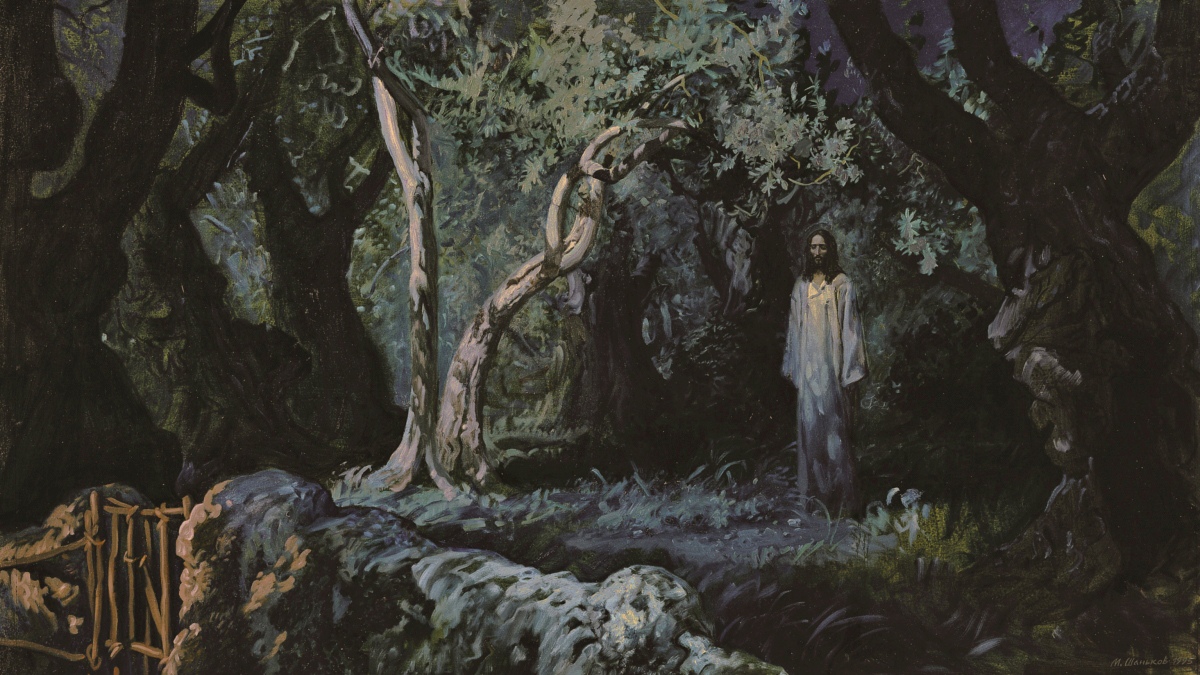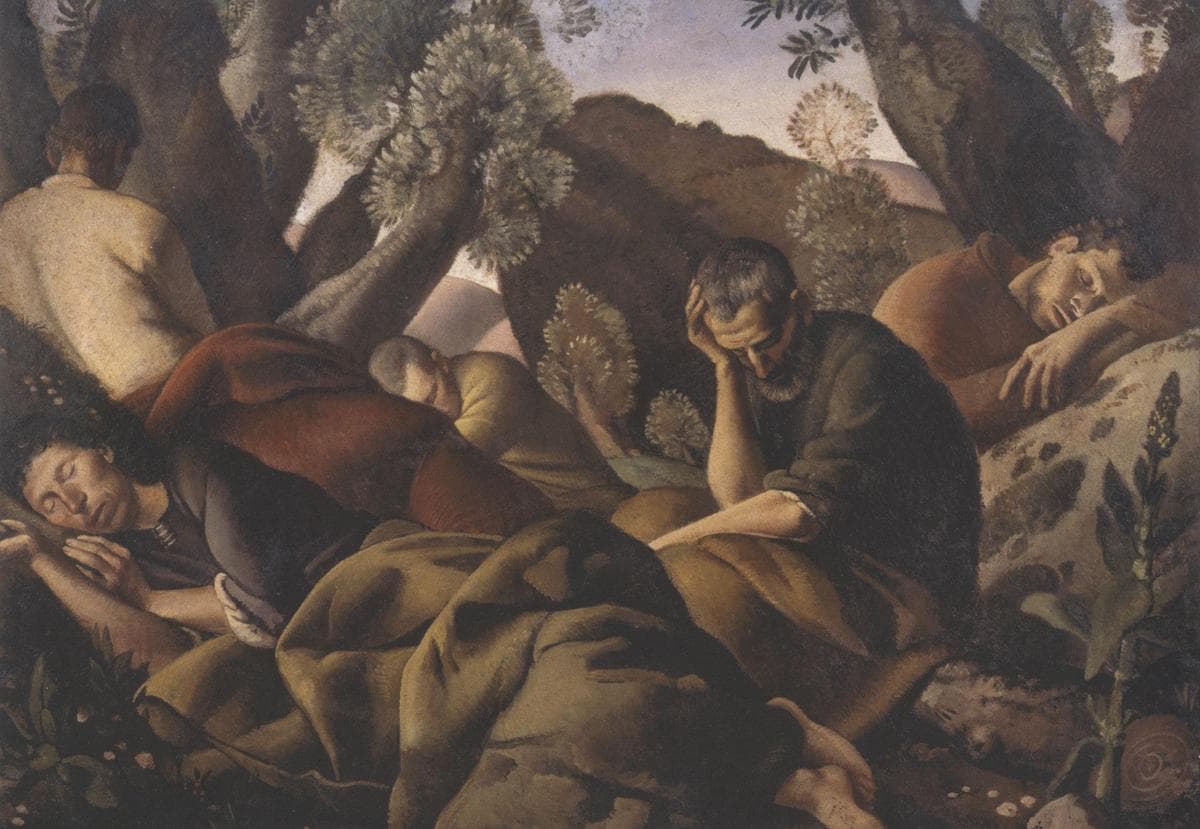April 2: Asleep or Awake?
♫ Music:
WEEK SIX
April 2 - April 8
STATIONS OF THE CROSS (PART I)
For the next two weeks we will be traveling together on the Way of Grief, Sorrow or Suffering known today as the Stations of the Cross. The Stations found their roots in early medieval pilgrimages to the Holy Land. Pious Christians traveled to Jerusalem where they retraced the final journey Jesus walked on the road to Calvary. The Via Dolorosa took/takes the faithful on a winding path within the ancient part of the city. For Christians who could not make the trip, a practice developed in western churches where fourteen depictions of Christ’s Passion were displayed on the interior walls of church naves. During Lent, clergy and parishioners process and pause before each station to meditate on the various accounts surrounding Christ’s death. In the traditional Stations, six are extra-biblical in nature. In 1991, Pope John Paul II introduced a new set of Stations called The Scriptural Way of the Cross, comprised of 14 biblical stations, passion accounts as recorded in the Gospels. We explore this Scriptural Way of the Cross in the days ahead.
Day 33 - Sunday, April 2
The Agony in the Garden
Scripture: Luke 22:41-46
And he withdrew from them about a stone's throw, and knelt down and prayed, saying, “Father, if you are willing, remove this cup from me. Nevertheless, not my will, but yours, be done.” And there appeared to him an angel from heaven, strengthening him. And being in agony he prayed more earnestly; and his sweat became like great drops of blood falling down to the ground. And when he rose from prayer, he came to the disciples and found them sleeping for sorrow, and he said to them, “Why are you sleeping? Rise and pray that you may not enter into temptation.”
Poetry:
"Disciples Asleep at Gethsemane"
by Paul Kane
II
Who was I to be chosen? It was late, and I understood
so little--though that little after my own fashion,
and who am I not to be accounted as good as anyone else?
I slept, and in my sleep knew I slept, and dreamed of being
awake--it was enough, surely, for I had been chosen.
Three times he returned and spoke, but I enfolded him
into myself, hearing him say, “Sleep, and take your rest.”
III
There was a meal, a hymn, some wine, and I followed,
wanting to be part of it all. We climbed a hill where
the trees were silver in the darkness, and a wind sighed
about us. It seemed to speak to my heart, saying, “This is
more than you,” and so I listened, and followed, knelt
and entered that voice. And then there were lights, a crowd,
confusion, a kiss, and a naked man running away into the dark.
IV
Three times nothing--still nothing, and those
brought to keep faith sleep in the garden.
The master dead, the dream erodes from within,
and sweet hope is made sweeter by perversion:
when it comes down to one, it comes down.
The land is gall--nor milk, nor honey flow,
and false friends keep watch unawake.
ASLEEP OR AWAKE?
Today’s Lenten passage takes us to Jesus in the Garden of Gethsemane where in agony he prayed to the Father and summoned his disciples to keep watch with him.
What loyal friends they were—falling asleep three times, surrendering their faithfulness to the lateness of the night. The escalating pulse of their exhausted hearts beat to the rhythms of conundrum that blur the sounds of dreams and reality, sleepiness and wakefulness, fading voices in and out. They have left their master and friend alone in his excruciating agony and dark abyss. Drowning in sorrow and confusion, they consent to their self-medicating sorrows. They use the drug of sleep as a panacea to alleviate their pain, the pain that enters into that of their suffering friend.
We may scorn the laziness and the lack of integrity of the disciples, but we find ourselves a little too akin to them. Paul Kane's poem “Disciples Asleep at Gethsemane” uses the first person perspective to invite us to become one of the disciples who have fallen asleep in the garden. We quickly find ourselves lulled into slumber.
In similar moments of temptation, we are swayed because of our own fear and inadequacy. Perhaps it is our shame, our overwhelming smallness, our self-preserving sorrow, or our numbing complacency that causes us to escape to our dreams. We want to be part of it all, but when we recognize that what we want is bigger than ourselves, we fall into the sleep of resignation. Facing our own smallness and weakness, we are drawn away from the one who summons us to be awake--to resist temptation.
How do we participate when he asks us to enter into what is beyond ourselves?
Christ in the Garden of Gethsemane by Mikhail Shankov depicts Jesus alone. As we meditate on the face of Jesus in this painting, I also invite you to imagine the face of Christ looking at his friends that have fallen asleep, especially when he had asked them to stay awake with him (Apostles by Felice Carena). These are the faces of the one who witnessed betrayal at every hand.
The lonesome Christ in the Garden of Gethsemane stands surrounded by both light and darkness. These two halves of the painting juxtapose the two sides of Jesus’ nature—being fully human, he feared suffering and wanted to avoid it; yet being fully divine, he had the strength to accomplish his mission.
Our finite human fragilities fear suffering and want to avoid it, especially when we are called to be awake in the midst of our own or another’s pain. These fragilities are dark shadow moments that lure us into sleep but the light stands resilient. Moments of darkness help us to know that the light is also present and that the light of Christ strengthens us to do what he ultimately calls us to do—to be his hands and feet to those who are suffering and going through periods of temptation. Juxtaposing light and darkness characterized Christ’s own struggle and beckons us to choose between sleep or wakefulness, courage or cowardice, friendship or betrayal.
Let’s choose to be fully present with our friend Jesus, when spiritual sleepiness tries to swallow our faithfulness. I invite you to enter into the light that awakens us to watch and pray with Christ.
PRAYER
Faithful Christ,
We are grateful for your faithfulness
Even when darkness tried to seize you
and agony resides within.
You withstand
By keeping awake
As your light comes in
to conquer the breath of darkness
That we have inhaled for too long in the midst of our fears.
May such light
fill up the lungs of our restless breath
Awaking us to life,
So we too may be faithful to you,
Waking or sleeping,
Thy presence our light.
Erin Choi,
M.Div student at Fuller Theological Seminary,
Emphases in Justpeace Making and Theology & the Arts
About the Artwork #1:
Christ in the Garden of Gethsemane (1995)
Mikhail Shankov
Oil on canvas
About the Artist #1:
Mikhail Shankov (b. 1962) is a member of the Academy of Fine Arts Russia. His work represents traditions of the classical school of painting and explores different periods of Russian history. Shankov creates large-scale paintings, continuing the traditions of the great Russian masters Vasily Surikov and Ilya Repin. He lives and works in Moscow.
About the Artwork #2:
Apostles (1926)
Felice Carena
Oil on canvas
About the Artist #2:
Felice Carena (1879-1966) was an Italian painter who lived and worked in Florence, Rome and Venice. Carena was heavily influenced by the style of the French modernist masters Paul Cézanne and Henri Matisse.
About the Music #1:
“Keep Watch With Me”
Lyrics:
Keep watch with me, keep watch with me,
pray with me and do not be afraid;
keep watch with me, pray with me
and do not be afraid;
keep watch with me,
pray with me and do not be afraid.
About the Composer for Music #1:
Margaret Rizza (b.1929) began to compose music in 1997. Since then she has become a major personality in the world of Christian choral music. Composing music follows Rizza’s illustrious career as an opera singer under the name Margaret Lensky. Her singing career spanned 25 years. Currently Rizza leads retreats, days of prayer, music and meditation sessions, as well as vocal and choral workshops.
http://www.margaretrizza.com
About the Music #2:
“A Prayer Like His”
Lyrics:
On the Mount of Olives He prayed,
“Father if possible, let this cup pass from me.”
On my knees, dear Lord, I do pray,
“Why all my suffering, if it is you I seek?”
Will you remain with me when all the light
disappears, and the darkness surrounds me?
Surrounds me.
And will you be my shield
against the threat of the foe,
against the constant temptation to let go?
Father, Father, Father…
In this time of sorrow and pain
I’ve become vulnerable, with no direction.
Order all my steps in your word.
Do not forsake me Lord,
Am I not your handmaid?
I am not worthy, O God,
that you should come to my aid,
but all I need is a word of yours to heal me.
For I have come to believe that
only you have the words,
the words to grant me salvation and healing.
Father, Father, Father…
As you walk upon the water,
Lord, I hear you call my name,
and I walk towards you but I’m sinking,
rescue me!
Father, Father, Rescue me.
On the Mount of Olives He prayed,
“Father, if possible, let this cup pass from me.”
About the Composer/Performer for Music #2:
Lupe Ríos comes from Ciudad Guzmán, Jalisco, México. He is one of 12 brothers and sisters born to a poor but happy family full of dreams and ambitions. When Lupe was a young boy, his family immigrated to the United States. In the USA he immersed himself in religious music. Lupe attended the University of Washington where he studied Political Theory and Economics with minors in Human Rights, Religion, and Music. He has served as the Director of Worship for Mission San Luis Rey Parish in Oceanside, CA, and is currently Director of Music at Mary, Star of the Sea Catholic Church in La Jolla, CA, where he is involved in a variety of music projects, including composing and recording.
http://lupedifranco.com
About the Poet:
Paul Kane (b. 1950) is an American poet, critic and scholar. Awards for his work include fellowships from the National Endowment for the Humanities, the Guggenheim Foundation, the Bogliasco Foundation, Fulbright, and an honorary doctorate from LaTrobe University in Australia. As a scholar of American literature, Kane writes primarily on the work of the Transcendentalists, particularly Ralph Waldo Emerson, but he also focuses on contemporary poetry and criticism.

